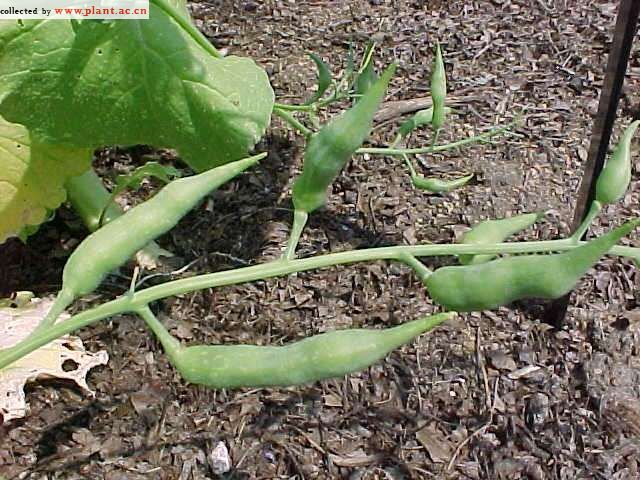Raphanus sativus CaudatusPodding radish, Rattail radish
科:十字花科
Family:Brassicaceae
属:萝卜属
common name:Podding radish, Rattail radish
introduce:Plant Type: Annual
Family: Brassicaceae
Missouri Native: No
Native Range: India and Southeast Asia
Height: 2 to 5 feet
Spread: 0.5 to 1 foot
Bloom Time: -
Bloom Color:
Sun: Full sun (only)
Water: Medium moisture
Maintenance: Medium
General Culture:
This edible seed-pod-bearing relative of the everyday radish can be started in peat pots or sown directly into the garden anytime from 3 weeks before the last spring frost through at least the end of July. Sow about 6" apart with 1 1/2 to 2 between rows, in full sun and fertile, well-drained soil. Mulch, fertilize regularly, and keep well watered to reduce bitterness. Plants grow very tall, and can reach 30" quickly, with an eventual height of up to 5 feet. Keeping them in tall tomato cages or otherwise restraining them will greatly facilitate harvesting the edible seed pods. Pods must be harvested young and small, as early as 5 weeks after planting and continuously after that.
Noteworthy Characteristics:
The podding radish and its close relative the "regular" radish have had a long relationship with man. China is believed to be the country of origin, since truly wild forms have been found there. Middle Asia and India appear to be secondary centers where many different forms developed after the plant was introduced from China in prehistoric times. Third-century B.C. Greeks wrote of their radishes, and by 100 A.D. Roman writers described small and large types, mild and biting varieties, and round and long forms. A German botanist in 1544 reported radishes of 100 pounds. Radishes appear to be one of the first European crops introduced into the Americas, closely behind the arrival of Columbus.Podding radishes have no thickened root (radish). Instead, the gardener desires this radish to bolt (go to seed) as quickly as possible so that the seed pods may be harvested and eaten. The botanical name, Raphanus caudatus, literally means "radish with a tail," describing the 3- to 12-inch tapered green or purple seed pods. Abundant flowers, usually yellow, appear on the plant quickly and are soon followed with great numbers of edible seed pods.
Problems:
Problems are similar to other Brassicaceae.
Uses:
Pods must be harvested about half grown. At that stage the texture is crispy, tender, and very mild. They may be used fresh in salads, steamed, boiled, or in stir fry. As the pods mature they will become hard, spicy, hot and bitter, and unsuitable for eating.
